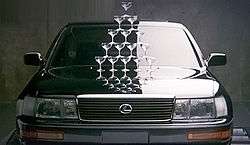
Artò
Artò is a frazione (and parish) of the municipality of Madonna del Sasso, in Piedmont, northern Italy.
Overview
It is a village located some km west from the Lake Orta.
History
Since 1928 Artò was a separate comune (municipality).
References
External links
![]() Media related to Artò at Wikimedia Commons
Media related to Artò at Wikimedia Commons

Artà
Coordinates: 39°42′N 3°21′E / 39.700°N 3.350°E / 39.700; 3.350
Artà is one of the 53 independent municipalities on the Spanish Balearic island of Majorca. The small town of the same name is the administrative seat of this municipality in the region (Comarca) of Llevant.
Population
In 2008 the municipality of Artà had a population of 7,113 recorded residents within an area of 139.63 square kilometres (53.91 sq mi). This equates to 50.9 inhabitants per km2. In 2006 the percentage of foreigners was 13.2% (890), of which Germans made up 3.9% (262). In 1991 there were still 136 illiterates in the municipality. 1,292 inhabitants had no education, 1,675 only a primary school certificate and 1,210 had secondary school leaving certificates. The official languages are Catalan and Spanish (Castilian). The Catalan dialect spoken on the island is known as Mallorquí.
Geography
Location
Artà lies in the northeast of the island of Majorca, around 60 km from the island's capital of Palma. The Massís d’Artà, the highest and most compact massif in the eastern mountain chain of the Serres de Llevant, occupies more than half the area of the municipality. The municipality is located on the western part of peninsula of Artà and is bordered in the west by the Bay of Alcúdia (Badia d’Alcúdia), and in the north by the Mediterranean sea where its coast lies opposite the neighbouring island of Minorca. The coast of Artà stretches for 25 kilometres and, so far, has escaped being developed. Particularly noteworthy are the beach and sand dune formations of sa Canova d’Artà, the flat coastal strip near the settlement of Colònia de Sant Pere, the high rocky coves of the Cap de Ferrutx and a large number of smaller bays that extend from s’Arenalet des Verger to Cala Torta.
The V.I.P.'s
The V.I.P.'s were a British R&B musical ensemble formed in Carlisle, Cumberland, (North West England) in late 1963, out of an earlier outfit known as The Ramrods, who had formed in Carlisle in 1960. After a change of personnel in April 1967, the band changed their name to Art, and released the album Supernatural Fairy Tales. They also participated to a psychedelic bizarre album called Featuring The Human Host And The Heavy Metal Kids by a collective known as Haphash And The Multi Coloured Coat, formed by Guy Stevens and an influential British graphic design and avant-garde musical partnership between Michael English and Nigel Waymouth. The musicians involved in that project were Mike Harrison on keys and vocals, Luther Grosvenor on guitars, Greg Ridley on bass and Mike Kellie on drums, as well as performances by Guy Stevens, Michael English and Nigel Waymouth. It was the first time that the term heavy metal was ever used in music, even though that album had nothing to do with heavy metal, being closer to psychedelic music. That album was published in 1967 on Liberty Records and contained only five songs from two minutes to more than 15 minutes of psychedelic and almost meditative state kind of music.

Balance (Ty Tabor album)
Balance is a 2008 solo album by King's X guitarist Ty Tabor. All songs were written, recorded and produced by Tabor, and the album was recorded at Alien Beans Studios in Katy, TX.
This is the first solo project released by Tabor for the Molken Music label.
Track listing
All tracks by Ty Tabor
Personnel
Balance (puzzle)
A balance puzzle is a mathematical puzzle which challenges the solver to distribute a subset of numbers so that the several sides of a stylized diagram representing a balance scale are equal. The balance puzzle is a classical number puzzle in the World Puzzle Championship. It consists in a mobile or tree structure, with designated positions where the player must hang specified weights, so that everything balances. See examples below.
There are usually 8 to 12 consecutive numbers (weights) to place, which makes it much smaller than, for example, sudoku.
As in many mathematical puzzles, the solution is unique. Expert puzzlers often prefer puzzles where the rules explicitly states that there is only one solution. This property allows for some reasoning strategies. It also makes generating puzzles a bit more difficult.
Examples
Variants

Balance (advertisement)
Balance was a 1989 television advertisement for the Lexus LS 400, which also introduced the luxury car make Lexus to American television audiences. It was created by Team One, a unit of Saatchi & Saatchi. The ad was designed to promote the engineering attributes of the flagship Lexus sedan. The advertisement received several awards and was emulated by later versions.
Synopsis
The advertisement showed the Lexus LS 400 on rollers, with a set of champagne glasses stacked on its hood. The LS400 engine and drivetrain were required to quickly accelerate from stop and shift through all the gears to reach the equivalent top speed of over 145 mi (233 km) per hour. Despite the quick shifts and the fast speed, the LS 400 engine produces no vibrations to upset the champagne glass pyramid, and not one drop of liquid is spilled. The narration reads, "After years of intense work, Lexus is ready to celebrate...because even at the equivalent of 145 miles per hour, the Lexus LS 400 is designed to stir the soul...and not much else."

Mara (supermarket)
Mara is a Romanian supermarket chain operating 2 supermarkets in Focşani.
External links
Podcasts:

